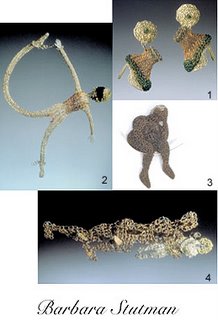 Here are the names of all the pieces: 1. Maintaining the status quo, 2. Raped, 3. Portrait of a rape victim, 4. Dark cloud from the past. The idea of turning a tragedy into jewelry is an admirable concept, in my opinion. When you cannot change a catastrophic event in your past, instead of letting that event define your future, you can proudly display your scars for the world to see, as one way of spitting in the face of your persecutor - be it man or fate - and showing that, by refusing to be destroyed, you are victorious after all.
Here are the names of all the pieces: 1. Maintaining the status quo, 2. Raped, 3. Portrait of a rape victim, 4. Dark cloud from the past. The idea of turning a tragedy into jewelry is an admirable concept, in my opinion. When you cannot change a catastrophic event in your past, instead of letting that event define your future, you can proudly display your scars for the world to see, as one way of spitting in the face of your persecutor - be it man or fate - and showing that, by refusing to be destroyed, you are victorious after all.That's what Ali Shalal Qaissi has decided to do. Remember him? He's the man under the hood in the infamous picture from the Abu Ghraib prison.
According to the New York Times [http://tinyurl.com/lwwjw], Mr. Qaissi «was arrested in October 2003, he said, because he loudly complained to the military, human rights organizations and the news media about soldiers' dumping garbage on a local soccer field. But some of his comments suggest that he is at least sympathetic toward insurgents who fight American soldiers. "Resistance is an international right," he said. Weeks after complaining about the garbage, he said, he was surrounded by Humvees, hooded, tied up and carted to a nearby base before being transferred to Abu Ghraib. Then the questioning began...»
«Mr. Qaissi is today a self-styled activist for prisoners' rights in Iraq. Shortly after being released from Abu Ghraib in 2004, he started the Association of Victims of American Occupation Prisons with several other men immortalized in the Abu Ghraib pictures». This is his calling card:

«Financed partly by Arab nongovernmental organizations and private donations, the group's aim is to publicize the cases of prisoners still in custody, and to support prisoners and their families with donations of clothing and food.
Mr. Qaissi has traveled the Arab world with his computer slideshows and presentations, delivering a message that prisoner abuse by Americans and their Iraqi allies continues. He says that as the public face of his movement, he risks retribution from Shiite militias that have entered the Iraqi police forces and have been implicated in prisoner abuse. But that has not stopped him.
Last week, he said, he lectured at the American University in Beirut, on Monday he drove to Damascus to talk to students and officials, and in a few weeks he heads to Libya for more of the same.
Despite the cruelty he witnessed, Mr. Qaissi said he harbored no animosity toward America or Americans. "I forgive the people who did these things to us," he said. "But I want their help in preventing these sorts of atrocities from continuing."»
He is free from fear and hatred. I call that a victory.
Update on 16-03-2006:
Salon [http://tinyurl.com/qg95w] has now raised some doubts about the accuracy of the NY Times' article.
«In an e-mail interview, a spokesman for CID [US Army's Criminal Investigation Command] confirmed that investigators had concluded the photograph shown on the front page of the Times was not Qaissi. "We have had several detainees claim they were the person depicted in the photograph in question," the CID spokesman told Salon. "Our investigation indicates that the person you have cited from the NY Times is not the detainee who was depicted in the photograph."
Ethan Bronner, the deputy foreign editor of the Times, said the newspaper was now investigating the possibility that two people were depicted in the photographs. He said the newspaper was no longer certain that the picture it ran on the front page depicted Qaissi. "Serious legitimate questions have been raised," Bronner said...
A lawyer representing Qaissi confirmed to Salon Monday night that the Times had made a mistake. "He [Qaissi] believes that there are two different people depicted in the photographs," said Jonathan Pyle, of Burke Pyle LLC. "Ali believes that the picture of himself is the one with his arms pointed diagonally down." Qaissi uses this photograph on his business card.»


No comments:
Post a Comment